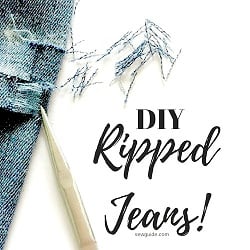
If you have bought raw denim jeans or jeans with denim fabric with even coloring, you are not at all wrong in wanting a worn look. The been-there, done-that jeans have an undeniable charm. It is justifiable that you need some custom personal touches to the jeans you have bought and feel that it looks brand new – no do. Who wants to wait for 100 years or pay thousands to get that distressed look you covet?.
It is possible to add a little craziness and creativity to the denim. Let us look at how the professionals do it, and maybe some of them we can replicate at home.
Do you know that a long time ago, you would have had to wash your new jeans necessarily before you could wear them straight from the retailer?. It was almost impossible to wear them. They were very stiff. It is impossible to imagine today.
The jeans you get nowadays come through so many treatments, processes, and washes that you can wear them straight off the shelf. No uncomfortable scratching or stiff-as-stick feeling.
The denim you get molds itself on your body like a second skin. Most of the jeans come prewashed and pretreated – Unless you prefer raw denim.
The denim industry has invented many ways to make denim the way people want it. Designers and denim manufacturers use many techniques like Laser engraving (in which laser light is used to remove the color of the denim) to get a faded & worn-out look.
Acid washes, sandblasting, enzyme washes, sun washing, water jet fading, overdye tinting, and ozone fading are some of the many complicated methods used by jeans manufacturers today for that desired distressed look.
You need some basic tools in your kitty to start distressing your jeans – nothing complicated.
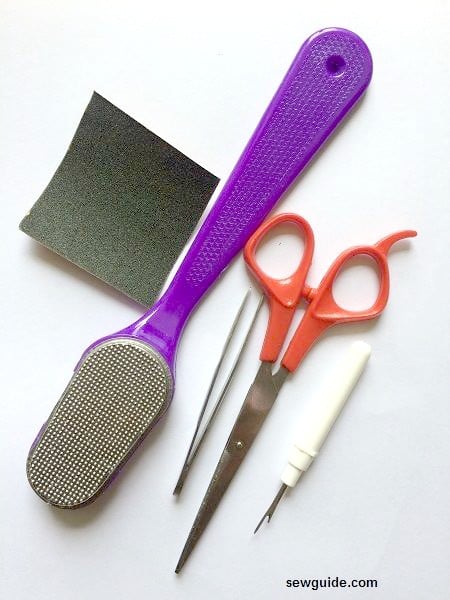
Different ways to distress jeans

Stone washing
This is the most commonly used method, in which Pumice stone is used to give an abrasion to the denim. Freshly made denim jeans are tumbled in the washer with stones. Pumice stone is a lightweight stone with a rough surface. When it is put in the washer with the fabric, the resultant abrasion gives the fabric a nice weathered & worn look.
Turkish stone, which is porous and clean, is used generally.
The advantage of stone washing is that when the fabric is treated with stone, the fibers on the surface break and the white yarn on the inside of the denim is visible from the outside.
How to do it at home – I would not advise you to do it in your washing machine. A washer is costlier than denim jeans!
You can keep your denim in a tub of water and some stones to replicate the process. But you need to do a lot to make much change.
Scrapping and rubbing the surface of denim with a pumice stone can achieve an almost similar effect and is better than tumbling with stones. One – the washing machine is destroyed, another – the rivets and other metal hardware are all abraded. There is no selective abrasion in stone washing in the washer.
Rinse wash
This involves washing the jeans in high-temperature water.
How to do it at home – Wash the jeans in water that is heated to about 50 degrees Celsius. This will fade the color of the jeans. If you want to brighten up the color of an old faded one, add it to this wash alongside your new one to get some of the dye on it.
Acid wash
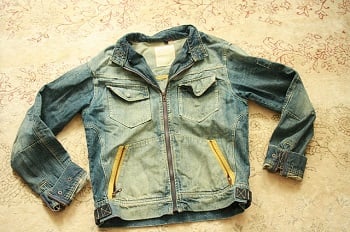
It is a chemical wash used on denim that strips the color from the fabric. The color on the surface is removed from the top layer of fibers, whereas the lower fibers retain the color. The result is a very faded and patchy look which is very much sought after.
The acid used is Sodium hypochlorite ( 5 to 10%) or potassium permanganate ( 3-6%)
How to do it at home – You can splatter diluted bleach rubbed on the jeans or keep the jeans tied in a bleach solution.
Learn about bleach printing here.
Whiskering
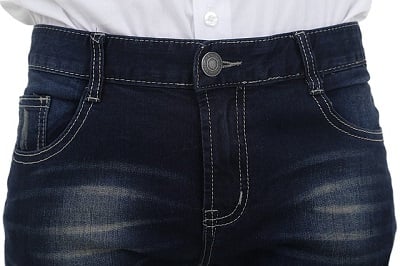
This is known after the cat’s whiskers and appears as fine lines from the crotch and hip area naturally with time and use.
You can make the selective Fading jeans on creases resulting in whiskers, unnaturally.
In an industrial setup, this process is done by stretching the fabric on balloons shaped like the creases in the fabric. Whiskering is done with the help of machine sanding, sandblasting, or laser technology in an industrial setup. This is also called atari in Japanese.
How to do it a home – Mark the lines you need to make, which look like the creases made naturally. Do Hand sanding with sandpaper. Sandpaper is used on specifically marked pattern lines.
Where to make the whiskers – Usually along the Hips, front thigh area, back of knees and side of knees.
Grinding
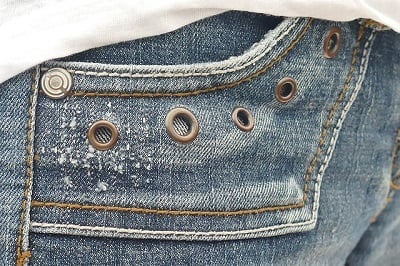
This will produce worn fibers on selective areas of the denim, especially the edges. A special tool is used to scrap areas of the fabric.
You can do it with the help of pumice stone rubbing, sandpaper rubbing, and a grinder tool. You can do this along the hem, belt loops, and pocket edges.
Sandblasting
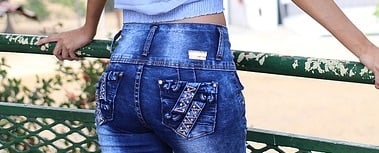
In this process, Denim is hit with high-speed guns of sand (granular or powdered) mixed with air to make a weathered look on the fabric. The selective areas which are sandblasted reveal the white yarn under the top layer of denim.
Sandblasting uses granular sand, which is passed through the nozzle of a gun. Machine sanding is highly skilled and uses specialized machinery ( rolls).
How to do it at home – You can hand sand/ hand scrub your denim with sand paper to get a similar look. You can create a number of beautiful looks with this method.
Do not forget to wear a protective mask.
The crotch area and back of the knees are given an aged look by fading or highlighting. A selective area is scrubbed by stretching the fabric ( In a professional setup, the denim is stretched on inflated balloons). The areas you do this are the front thigh, back seat, back panel near the bottom, or front panel near the knee.
Bleaching /bleach wash
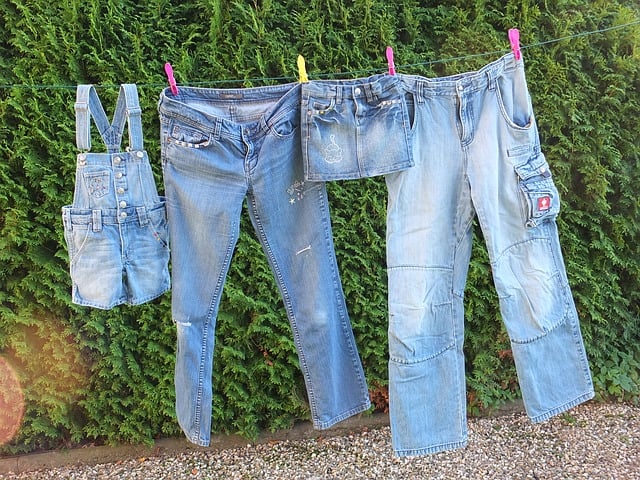
Bleaching will completely reduce the dark indigo color of denim to a very light shade. Hydrogen peroxide and sodium hypochlorite are the chemicals used in bleaching. It is done along with the stone washing or alone.
How to do it at home – You can fade denim by giving a wash of diluted bleach. The effect you get will depend on the amount of bleach you use and the duration. Remember to properly wash off the bleach after beaching so as not to damage your fabric. Yellowing will result from overzealous bleaching.
Some precautions :
- Never take bleach in a stainless steel pot.
- Use a mask when using bleach.
- Use good-quality bleach.
Do not keep it for too long – yellow is not an attractive colour on denim. And the fibers will erode.
Here is a post on using bleach on clothes. And also how to paint on fabric with bleach
Checkout an excellent video explaining how to bleach denim
Wrinkling
Through this process, a crease is made on the fabric. Usually, in all other clothes, we look for wrinkle-resistant material, but denim is one where no one thinks about wrinkles as undesirable.
In an industrial setup, wrinkles or folds are made on the fabric with the help of a resin and treated under heat to get the look of permanent folds/creases. The denim fabric is tied tightly and then treated with resin.
How to get the look of wrinkles – After washing the jeans, tie it tightly and then wring it and dry. Do not iron
Tacking
Denim fabric is folded ( 2-5 folds) where you want to tack (fix it in place with tacks or stitches). The area is tacked through the folds. Denim is then washed or treated, creating patterns on the fabric.
This is usually done on selected areas like the waistband/hems and pockets.
Spraying
Potassium permanganate solution is sprayed on the fabric. This is usually done in areas where you have done the sandblasting. A spray gun is used to spray this solution on the area in desired patterns. A deep brown color is obtained on the area where you have sprayed. Sponging is also done for a similar effect.
How to do it at home – Spraying the denim with a diluted bleach solution or dye will produce creative patterns.
Patterns – Chevron / star shapes
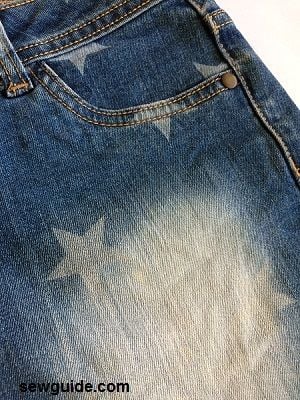
Mark the pattern on the garment (Use a stencil for similar and interesting shapes). Use emery paper rolled on a wooden stick or plastic stick to make (scrub) these patterns.
Ripping, pilling and cutting
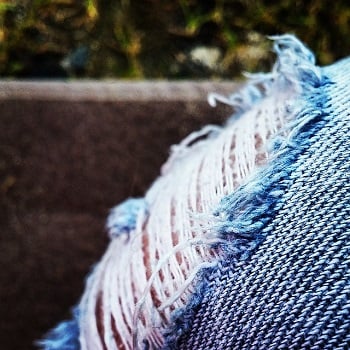
This involves making holes in jeans; clippers, knives and blades are used to make these effects.
Warp yarn is cut by the blade and white weft yarn is left in place. Cuts should always be kept weft-wise, i.e., horizontal in the garment. The weft will be kept in place, and the warp thread will be removed when you wash the garment.
Checkout the easy way to rip your jeans without removing the white thread in this tutorial.
Cutting the edges at the hem, pocket edges, fly and knee area before the (stone) washing also creates a very distressed look.
Overdyeing
This involves additional dyeing with a dark colour after the jeans is made. Checkout how you can get that effect and more with this video tutorial.
Tinting
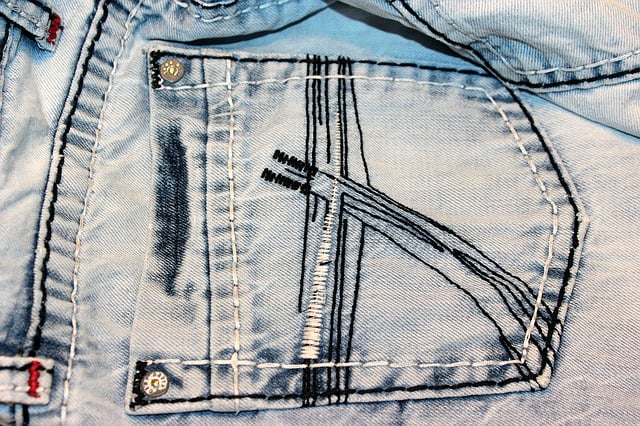
Tinting means dyeing to give a change of tone / hue of the denim. Tinting on selected areas is usually done to give a very vintage look to the denim.
Snow washing
This denim washing (a type of acid wash) involves tumbling of jeans with pumice stone soaked in chlorine bleach. A snow-like pattern that looks like frosting is formed by this process. Where the stone touches the fabric the color is stripped off from there.
Related posts :12 important jeans washes and surface treatments; Different types of denim; Different types of jeans; Jeans Repairs – 7 common scenarios; How to repair holes on jeans; How to alter tight jeans ; How to replace jeans buttons; How to make a cuff on jeans ; How to recycle old jeans

